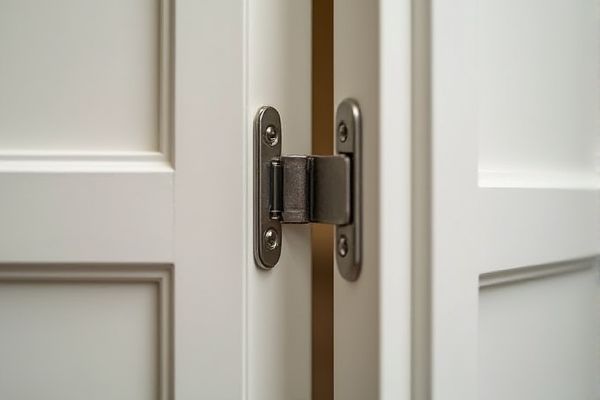
Soft close hinges reduce noise and prevent cabinet doors from slamming shut, offering a smoother and quieter closing experience, while spring-loaded hinges use a spring mechanism to automatically close doors, which can be less gentle but convenient for hands-free operation. To understand which hinge best suits Your needs and maintain longevity in cabinetry, explore the detailed comparisons in the rest of this article.
Table of Comparison
| Feature | Soft Close Hinges | Spring-Loaded Hinges |
|---|---|---|
| Function | Slowly closes door to prevent slamming | Automatically closes door using spring tension |
| Noise Levels | Quiet, minimal noise on closing | Can cause clicking or snapping sounds |
| Installation Complexity | Moderate, requires precise alignment | Simple, easier to install |
| Durability | High, designed for frequent use | Moderate, springs may wear out over time |
| Typical Use Cases | Kitchen cabinets, bathroom doors, furniture | Screen doors, lightweight cabinet doors |
| Cost | Higher price point | More affordable |
Introduction to Cabinet Hinges: Soft Close vs. Spring-Loaded
Soft close hinges use a hydraulic mechanism to gently slow the door as it closes, preventing slamming and reducing noise and wear. Spring-loaded hinges rely on a built-in spring to automatically return the door to a closed position, providing consistent closure but lacking the gentle cushioning effect. Choosing between soft close and spring-loaded hinges depends on the desired balance between quiet operation and automatic door closure in cabinetry.
How Soft Close Hinges Work
Soft close hinges operate through a built-in hydraulic or pneumatic mechanism that slows the door's movement as it approaches the frame, preventing abrupt closure and reducing noise. This mechanism absorbs kinetic energy, ensuring a smooth, controlled shut that protects cabinetry from wear and damage. Unlike spring-loaded hinges, which rely on spring tension to push doors closed quickly, soft close hinges emphasize gradual, silent closing action.
How Spring-Loaded Hinges Function
Spring-loaded hinges function by using a coiled spring mechanism that exerts constant pressure to close doors or lids automatically after being opened. This action provides smooth, controlled movement without requiring manual effort to shut, ensuring that your cabinets or furniture close securely every time. Unlike soft close hinges, which rely on hydraulic dampers to slow the door's motion, spring-loaded hinges rely solely on mechanical tension for operation.
Noise Reduction: Which Hinge Performs Better?
Soft close hinges are designed with integrated dampers that significantly reduce noise by controlling the door's closing speed, preventing slamming and ensuring a gentle, quiet operation. Spring-loaded hinges use a metal spring mechanism to automatically close doors, but they often lack noise-dampening features and can produce louder sounds due to the sudden snap shut. For superior noise reduction, soft close hinges outperform spring-loaded hinges by minimizing impact noise and enhancing overall acoustic comfort in residential and commercial settings.
Durability and Longevity Comparison
Soft close hinges feature advanced damping mechanisms that reduce wear and tear by preventing doors from slamming, resulting in greater durability and extended lifespan compared to spring-loaded hinges. Spring-loaded hinges rely on metal tension to close doors quickly, which can lead to increased stress on the hinge components and faster degradation over time. Choosing soft close hinges enhances your cabinet's longevity by minimizing mechanical strain and maintaining smoother operation for years.
Installation Process: Soft Close vs. Spring-Loaded
Soft close hinges require precise alignment during installation to ensure the damping mechanism functions properly, often involving adjustable screws for fine-tuning the closing speed. Spring-loaded hinges install more straightforwardly with fewer adjustment needs, relying on the inherent spring tension to control door movement. Both hinge types demand careful screw placement to maintain stability, but soft close hinges typically need more detailed calibration to achieve smooth, silent closing.
Cost Differences and Value for Money
Soft close hinges typically cost more upfront than spring-loaded hinges due to their advanced damping mechanisms that prevent slamming. Despite the higher initial investment, soft close hinges offer greater long-term value by reducing wear and tear on cabinets and providing a quieter, more refined user experience. Spring-loaded hinges, while more budget-friendly, may result in higher maintenance costs over time due to increased noise and faster component wear.
Safety Features and Child-Friendliness
Soft close hinges offer enhanced safety by preventing doors from slamming shut, reducing the risk of finger injuries, which makes them especially child-friendly for homes with young children. Spring-loaded hinges, while providing automatic door closure, may close too quickly, posing a higher risk of pinched fingers or accidental door slams. Selecting soft close hinges for Your cabinets or doors ensures a safer environment with gentle, controlled closing motion ideal for families prioritizing child safety.
Aesthetic Impact on Cabinets and Furniture
Soft close hinges provide a sleek and seamless aesthetic by eliminating the abrupt noise and motion associated with traditional cabinetry, enhancing the overall elegance of your furniture. Spring-loaded hinges, while functional, tend to cause rapid door movements that can detract from the refined appearance and longevity of cabinet surfaces. Choosing soft close hinges elevates the visual harmony and smooth operation, making cabinets appear modern and meticulously crafted.
Choosing the Right Hinge: Key Considerations
Soft close hinges provide controlled, silent door closing, preventing slamming and reducing wear, ideal for kitchen cabinets and furniture requiring smooth operation. Spring-loaded hinges offer self-closing functionality, beneficial for doors needing automatic closure but may produce noise and less precise control. Key considerations include noise level, closing speed, durability, and application environment to determine the best hinge type for specific furniture or door requirements.
 homyna.com
homyna.com